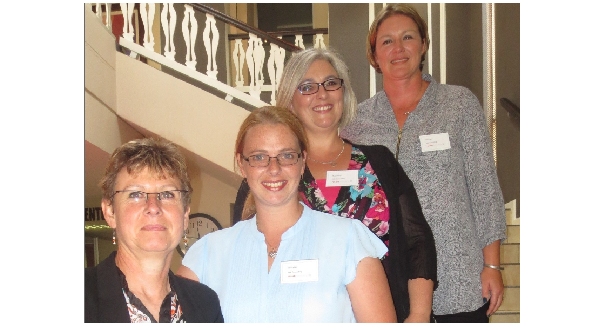NEMA EIA Regulations
Illovo, Johannesburg, South Africa: 4 February 2015 – SRK Consulting, a leading provider of consultancy services to the global mining, metals and natural resource sectors, hosted a workshop on 29 January 2015 in Johannesburg during which the new NEMA EIA Regulations, and the implementation thereof, were unpacked, discussed, debated and clarified for SRK’s mining clients at large. The intention was to demystify the new regulations.
The National Environmental Management Act (NEMA): Environmental Impact Assessment (EIA) Regulations, which came into effect on 8 December 2014, form part of a holistic attempt by government to consolidate regulations pertaining to the EIA authorisation process and support the development of an ‘One Environmental System’ for South Africa. The move impacts the mining industry in particular, as well as industrial and development projects which require EIA authorisation.
SRK Consulting’s Briony Liber, Principal Environmental Scientist and a Partner in the firm, hosted the morning session and got the ball rolling with an admission that, a year ago, SRK had joined the industry in greeting the proposed regulations with a mix of scepticism and confusion. “Over the past year we’ve had a chance to work through the information and engage in workshops with the Department of Environmental Affairs (DEA),” said Liber. “We now understand the principles behind the thinking and we are excited about the new regulations.”
Stressing SRK’s “absolute support for the new regulations”, Liber noted that the change harked back to the early days of Integrated Environmental Management (IEMs) in the 1990s, when there was little regulation around process and the driving force was risk management and the fostering of solid stakeholder relationships. While the NEMA regulations of the mid 2000s helped to level the playing fields and introduced regulatory timeframes and an identified process for EIA, they detracted from innovation in this space and, in some cases, saw the emergence of a ‘box ticking’ approach. “There was a shift to compliance rather than dealing with risk,” noted Liber.
With the arrival of the new 2014 EIA regulations the importance of social licence to operate, stakeholder relationships and pre-planning has again come full circle, with the permitting process currently being the only part of the new authorisation system to be regulated.
Indeed, the biggest takeaway from the session was an understanding that the new regulations shine the spotlight clearly on the need for social licence, through the development and maintenance of relationships with all stakeholders from concept through to closure, and not just when aiming to permit a project. As Franciska Lake, Principal Environmental Scientist at SRK, noted: “The authorisation process is not a new concept. The shift in thinking however is to commence the authorisation process once a project is well defined, as opposed to defining the project in parallel with the authorisation process.”
SRK’s Senior Environmental Scientist, Selma Nel, agreed, noting that with the strict permitting timeframes in place, project proponents cannot afford to start the EIA permitting 300 day ‘stop watch’ if they haven’t done their pre-planning and, most importantly, if the project description is still evolving. This is because the timeframes do not allow for any material changes to the project description. “You cannot afford any stumbling blocks,” she said.
Liber stressed: “Our recommendation to all our clients is that before you come to permitting, know who your stakeholders are, engage with them on project alternatives, identify opportunities to avoid impacts through designing them out of your project.” She added: “Don’t submit your application until you have a project description freeze, because you will very likely get kicked back to day one or miss your deadlines.”
While adapting to the new processes will require a careful and mindful approach by EAPs, Dee Fischer, Chief Director: Integrated Environmental Management at the DEA, was upbeat about moving forward with the industry. “We are excited. We believe it will change aspects that have been problematic,” she said.
Explaining the ins and outs of the regulations in more depth, Fischer noted that the central premise behind the changes was to create a parallel process for the full suite of permitting requirements, from water to waste management, air quality and basic assessments, scoping and Environmental Impact Reporting.
The aim is to reduce administrative steps within the EIA process to improve efficiencies, provide consistency, ensure greater guidance is offered, and, within a short period of time, create an online application process which will allow for greater screening and the collation of information. “We want to focus on the entire impact footprint,” explained Fischer, and create a greater alignment among permitting authorities by improving systems, processes and access to environmental data.
It will be key for independent consultants operating in this space and proponents to fully understand the opportunities provided in the amendments to the regulations and work within the new provisions. She also stressed that due to the limited timeframes for gathering additional information through the process, more negative decisions may be passed down if sufficient information is not provided during the process.”
For Fischer, one of the key changes enacted by the new regulations is the ability to now issue single or multiple environmental authorisations (EAs). This means that a single combined process may be undertaken for several activities of the same type at different locations or interrelated activities at the same or different locations, for example in an Industrial Development Zone, for which either a single or multiple EAs could be issued.
Other significant takeaways from the workshop included the following points:
- From submission of a basic application to a final decision will take a turnaround time of 197 days (or 247 days in exceptional circumstances).
- From submission of a scoping report and EIR (S&EIRs) the turnaround to a final decision will be 300 days (or 350 days in exceptional circumstances).
- Once environmental authorisation has been obtained, commencement of new activities will be limited to 10 years, thereafter the process would have to be repeated if timeframe of commencement is not met.
- Written consent (not just notification) from landowners (if different from the applicant) must be submitted with the application, except for mining applications, linear developments and Strategic Infrastructure Projects (SIP).
- Comment periods for the public and Organs of State are 30 days, and one comment period is allowed for each report (consultation is recommended to be undertaken prior to the submission of applications to build relationships, and not just under the regulated framework).
- Approved Environmental Management Programme Reports (EMPRs) and any amendments must be made available for inspection in an effort to “try to be more transparent and open”, explained Fischer.
- Applications will lapse immediately if regulated environmental authorisation timeframes are exceeded by the applicant. Re-application is possible but will incur a new application fee.
- Exemption and appeals regulations are promulgated separately.
In conclusion, SRK’s view is that, the quantum of work required to undertake an EIA is essentially unchanged, however proponents should not be lulled into the false sense of security that all this work can be completed in the 300 day authorisation period.
Critical to a smooth permitting process will be optimal use of the unregulated period ahead of submission of application to define the project in consultation with environmental and social specialists and stakeholders that could be affected by the project, to ensure that come the time to permit the project, no surprises crop up that prevent regulated authorisation timeframes to be met. It must be noted that if the applicant misses any of the deadlines, the application is automatically closed and will need to be restarted.
{{ commodity.name }}
{{ post.title }}
{{ post.date }}






Comments